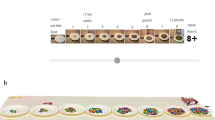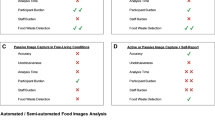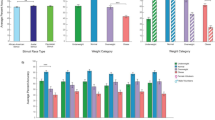Abstract
Objective:
The goals of this study were to investigate whether children and adolescents can accurately estimate portion sizes of preweighed food by viewing photographs of food, and whether age influences the ability to estimate food portion sizes.
Subjects:
A total of 63 male and female volunteers aged 9–19 y participated in the study.
Design:
Each participant received a photographic booklet with photograph series of 13 food items. Participants over 10 y of age were asked to estimate portion sizes of food on 34 plates placed in front of them by comparing the different portions to corresponding photographs of food. Younger participants were asked to estimate portion sizes of food on 17 plates by comparing the portions to photographs.
Results:
Participants made 2019 comparisons between actual food portion sizes and photographs of food portion sizes. On average, 60% of the comparisons were made correctly. A photograph directly adjacent to the photograph depicting the correct portion size was chosen in 35% of the comparisons and 5% of the comparisons were made incorrectly. Portion sizes were estimated more accurately when the actual served portions of food had exactly the same appearance as the foods portrayed in the photographic booklet. No differences existed between children's and adolescents' abilities to estimate portion sizes using photographs.
Conclusions:
Large variability may exist in an individual's capability of choosing a photograph that correctly depicts food portion sizes, but the error at the group level is quite small. These data indicate that a photographic booklet of foods can be a useful tool for portion size estimates in these age groups.
Sponsorship: The Norwegian Foundation for Health and Rehabilitation through Norwegian Health Association.
This is a preview of subscription content, access via your institution
Access options
Subscribe to this journal
Receive 12 print issues and online access
$259.00 per year
only $21.58 per issue
Buy this article
- Purchase on Springer Link
- Instant access to full article PDF
Prices may be subject to local taxes which are calculated during checkout
Similar content being viewed by others
References
Faggiano F, Vineis P, Cravanzola D, Pisani P, Xompero G, Riboli E & Kaaks R (1992): Validation of a method for the estimation of food portion size. Epidemiology 3, 379–382.
Frobisher C & Maxwell SM (2003): The estimation of food portion sizes: a comparison between using descriptions of portion sizes and a photographic food atlas by children and adults. J. Hum. Nutr. Diet. 16, 181–188.
Håglin L, Hagman U & Nilsson M (1995): Evaluation of the Meal Model ‘Matmallen’. A means of estimating consumed amounts of food. Scand. J. Nutr. 39, 79–83.
Hankin JH, Nomura AM, Lee J, Hirohata T & Kolonel LN (1983): Reproducibility of a diet history questionnaire in a case-control study of breast cancer. Am. J. Clin. Nutr. 37, 981–985.
Haraldsdottir J, Tjonneland A & Overvad K (1994): Validity of individual portion size estimates in a food frequency questionnaire. Int. J. Epidemiol. 23, 786–796.
Lucas F, Niravong M, Villeminot S, Kaaks R & Clavel-Chapelon F (1995): Estimation of food portion size using photographs: validity, strengths, weaknesses and recommendations. J. Hum. Nutr. Diet. 8, 65–74.
Nelson M, Atkinson M & Darbyshire S (1994): Food photography. I: The perception of food portion size from photographs. Br. J. Nutr. 72, 649–663.
Nelson M, Atkinson M & Darbyshire S (1996): Food photography II: use of food photographs for estimating portion size and the nutrient content of meals. Br. J. Nutr. 76, 31–49.
Nelson M & Bingham SA (1997): Assessment of food consumption and nutrient intake. In Design Concepts in Nutritional Epidemiology, eds BM Margetts & M Nelson, pp 123–169. Oxford: Oxford University Press.
Pietinen P, Hartman AM, Haapa E, Räsänen L, Haapakoski J, Palmgren J, Albanes D, Virtamo J & Huttunen J (1988): Reproducibility and validity of dietary assessment instruments. 1. A self-administered food use questionnaire with a portion size picture booklet. Am. J. Epidemiol. 128, 655–666.
Robinson F, Morritz W, McGuinness P & Hackett AF (1997): A study of the use of a photographic food atlas to estimate served and self-served portion sizes. J. Hum. Nutr. Diet. 10, 117–124.
Robson PJ & Livingstone MB (2000): An evaluation of food photographs as a tool for quantifying food and nutrient intakes. Public Health Nutr. 3, 183–192.
Slimani N, Deharveng G, Charrondière RU, van Kappel AL, Ocké MC, Welch A, Lagiou A, van Liere M, Agudo A, Pala V, Brandstetter B, Andren C, Stripp C, van Staveren WA & Riboli E (1999): Structure of the standardized computerized 24-h diet recall interview used as reference method in the 22 centers participating in the EPIC project. European Prospective Investigation into Cancer and Nutrition. Comput. Methods Programs Biomed. 58, 251–266.
Tjønneland A, Haraldsdòttir J, Overvad K, Stripp C, Ewertz M & Jensen OM (1992): Influence of individually estimated portion size data on the validity of a semiquantitative food frequency questionnaire. Int. J. Epidemiol. 21, 770–777.
Øverby NC, Lillegaard ITL, Johanson L & Andersen LF (2004): High intake of added sugar among Norwegian children and adolescents. Public Health Nutr. 7, 285–293.
Acknowledgements
This study has been financed with the aid of EXTRA funds from the Norwegian Foundation for Health and Rehabilitation through Norwegian Health Association.
Author information
Authors and Affiliations
Corresponding author
Additional information
Guarantor: ITL Lillegaard.
Contributors: ITLL contributed to study design, data collection, data analysis and writing of the paper. NCØ contributed to study design, data collection and draft of the paper. LFA contributed to study design, data analysis and writing of the paper.
Appendix A
Appendix A
Weights of the foods represented in the photographic booklet are given in Table A1.
Rights and permissions
About this article
Cite this article
Lillegaard, I., Øverby, N. & Andersen, L. Can children and adolescents use photographs of food to estimate portion sizes?. Eur J Clin Nutr 59, 611–617 (2005). https://doi.org/10.1038/sj.ejcn.1602119
Received:
Revised:
Accepted:
Published:
Issue Date:
DOI: https://doi.org/10.1038/sj.ejcn.1602119
Keywords
This article is cited by
-
Normal and unusual days for dietary intake during the 12 months after a breast cancer diagnosis in women
European Journal of Nutrition (2022)
-
Validation of repeated self-reported n-3 PUFA intake using serum phospholipid fatty acids as a biomarker in breast cancer patients during treatment
Nutrition Journal (2018)
-
The international food unit: a new measurement aid that can improve portion size estimation
International Journal of Behavioral Nutrition and Physical Activity (2017)
-
Depicted serving size: cereal packaging pictures exaggerate serving sizes and promote overserving
BMC Public Health (2017)
-
Dietary intake, leisure time activities and obesity among adolescents in Western Sweden: a cross-sectional study
Nutrition Journal (2015)



